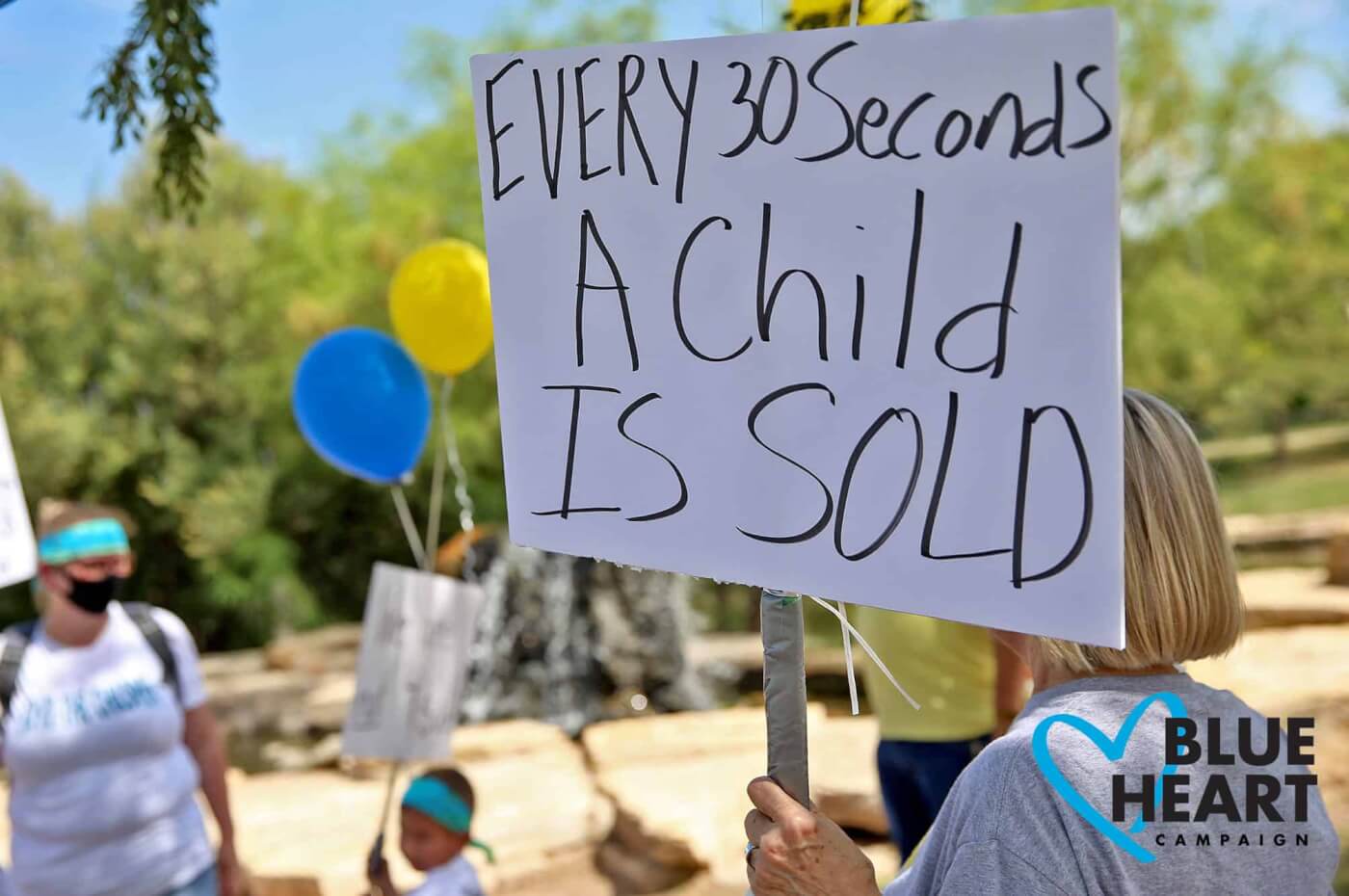30 July 2021, marks the 8th World Day against Trafficking in Persons. The theme of this year, “Victims’ Voices Lead the Way”, puts victims of human trafficking at the centre and highlights how important it is to listen and learn from survivors of human trafficking.
In 2018, about 50,000 victims of human trafficking were detected and reported. Due to the hidden nature of the crime, there are no definite figures of human trafficking at a global or regional scale. According to the International Labour Organisation (ILO), there are an estimated 40.3 million victims trapped in modern-day slavery, of which about 25 million are forced into labour and another 15 million forced in a marriage. The low number of victims in contact with authorities shows how unreported this crime is. Additionally, authorities struggle to properly identify and record victims of human trafficking if they show less obvious signs of trafficking. For example, so far women and girls travelling to Syria to join ISIS have been mostly overlooked as victims of human trafficking and instead treated as dangers to public security.
Human trafficking has many faces
Human trafficking can take many forms, such as sexual exploitation, domestic servitude, debt bondage, forced labour on construction sites, in the hospitality industry or the agricultural sector. Victims are forced to work without pay or with an inadequate salary, live in inhumane conditions and are vulnerable to physical, psychological and sexual abuse. Additionally, to exercise control over their victims, traffickers often withheld official documents, manipulate them and socially isolate them. Because human trafficking has so many different faces, authorities have to be extremely diligent to not ignore signs of human trafficking that are not commonly displayed by victims. Instead of having a “one-size-fits-all” approach, authorities need to be open in acknowledging various indications of human trafficking.
Findings from 2018, published in UNODC’s 2020 Global Report on Trafficking in Persons, reveal that in the last 15 years the share of children has increased by over 2.5 from 13% to 34% of detected victims. However, the majority of victims of trafficking remain women (46%) and girls (19%). Sexual exploitation continues to be the main motive for trafficking women and girls in more than 70% of cases. In contrast, male victims are mainly trafficked for forced labour. Other forms of exploitation among detected trafficking victims, which make up less than 12% globally, are criminal activity, begging, forced marriages, mixed forms, baby selling or the removal of organs.
The profile of offenders is with over 60% of persons investigated, arrested, prosecuted and /or convicted predominantly male, but women are especially active in the recruitment phase of trafficking. According to UNODC’s report, the majority of traffickers are business-enterprise-type organized criminal groups (36%) and opportunistic association of traffickers (29%), meaning at least two traffickers that are not systematically engaged, closely followed by individual traffickers (26%).
Recent Developments
The global economic downturn of the COVID-19 pandemic is expected to result in an increased risk of trafficking because lockdown measures and the loss of jobs exacerbated the economic vulnerability of already disadvantaged people around the world. Generally, about half of victims of trafficking are in a condition of economic need, such as an inability to have access to food, shelter or healthcare. Numbers from the Global Financial Crisis of 2007-2010 showing that the number of trafficking victims from countries with prolonged high unemployment rates increased reveal the relationship between unemployment rates and human trafficking. Furthermore, coercion by economic means also hinders the capacity of victims to leave the exploitative situation. Other pre-existing factors that traffickers take advantage of include a dysfunctional family or having no parental care, an intimate relationship, mental disorders, immigration status, limited knowledge of a foreign language, or a physical disability.
Human trafficking occurs in every region of the world and the UNDOC’s report from 2020 covers 148 countries. A study by the Global Initiative against Transnational Organised Crime from 2020 uncovered that 60% of surveyed migrants from the Sahel region and North Africa headed to Africa and Europe had been trafficked along the route. Long journeys resulted in multiple trafficking experiences and the top five countries where migrants had been trafficked were Libya, Algeria, Niger, Nigeria and Mali. Migrants with financial means were especially vulnerable to detention and kidnapping along the way, while migrants who work were more vulnerable to forced and unpaid labour. While sexual exploitation and organ trafficking were not common along routes, they did occur in the source countries.
However, the majority of human trafficking does not involve the crossing of a border, and most cross-border trafficking is limited to the same region. For example, in Nigeria – a source, transit and destination country of human trafficking – internal trafficking takes up three quarters of all cases in the country.
The use of the internet for human trafficking, which has increased dramatically over the past two decades, enables traffickers to broad their geographical scope without moving their location or the location of their victims. Social Media is used for recruitment and advertisements, while online platforms stream and broadcast the exploitation abroad. A case highlighted by UNODC reveals the related dangers of these developments: A single trafficker, working along, managed to sexually exploit and connect one victim with over 100 sex buyers over a period of 60 days using online advertisement.
Reprieve: British victims of trafficking victims in Syria

The importance of putting the victim’s voices at the core of anti-trafficking efforts has also been demonstrated by Reprieve’s report “Trafficked to ISIS”. So far, women and girls associated with ISIS have been mostly ignored, labelled as “ISIS-brides” and left alone with their traumatic experiences. However, the report documents how ISIS used trafficking tactics similar to those employed by child sex trafficking gangs to groom and recruit hundreds of women and girls. Reprieve revealed that at least 63% of the British women detained in North East Syria are victims of trafficking who were forced into marriage, sexual slavery, domestic servitude and other forms of exploitation. ISIS systematically has trafficked and exploited women and girls into Syria and Iraq to support the caliphate and legitimise the new ISIS state.
According to the report, almost half of British nationals were children when they travelled to Syria, some of them as young as 12. At least 44% of British women were coerced by a male partner or relative. Additionally, online grooming, fraud, deception and abuse of vulnerable positions were used to transport women and girls to Syria, coerce them into travelling to Syria or keep and move them within Syrian against their will.
After years of exploitation, these British women and girls escaped ISIS territory and are now indefinitely detained by the Kurdish authorities in the North of Syria, in refugee camps like Al-Hol where 517 people died in 2019, most of them children. In addition to the dire conditions in those desert camps, many governments do not provide help for their citizens fleeing from ISIS-rule. Instead, citizenship deprivations are being carried out to stop them from coming home. The UK government has deprived at least 19 of 25 British adults trapped in North East Syria which includes at least four women who travelled to Syria as children. Further the UK government refuses to repatriate adults as well as children that are not unaccompanied or orphaned. In other words, families are intentionally split up and mothers are being separated from their children indefinitely. As a result of these practices, victims of trafficking are impeded from accessing life-saving consular assistance and prevented from returning home.
It is vital to acknowledge that re-victimising and punishing victims of human trafficking for the crimes they were forced to commit by their traffickers only further stigmatises them and prevents them from receiving adequate support. The UK government has already failed in protecting at-risk women and girls from being trafficked to Syria for sexual exploitation, and is now denying suspected victims of trafficking their right to an effective remedy and their right to family life – based on harmful stereotypes that individuals associated with ISIS are a security threat, without taking into account their experiences as victims of trafficking.
Victims’ Voices
Malaika Oringo, who was trafficked at just 15 years from Uganda to the Netherlands, says she is not defined by her victim’s past, but instead carries her “victim’s scares as a badge of honour, as an inspiration to other survivors that there is life at the end of the tunnel”. She turned her bad experiences into something positive and has founded Footprint to Freedom, a survivor-led organisation creating opportunities for survivors to thrive and promote survivor engagement. When leading others out of exploitation, it is significant to include survivors because they “know first-hand how human traffickers operate and which strategies they use to bond victims to slavery.” Malaika Oringo acknowledges the progress made in recent years to include survivors, but remarks that
“it’s still quite unusual for the voices of survivors to feature significantly in international trafficking debates. Yet survivors’ voices are very vital in establishing effective anti-trafficking strategies that address prosecution, protection, and prevention.”
When Kyra Doubek talked to UNODC about her experiences of domestic sex trafficking and labour trafficking, she mentioned that she feels she is “one of the lucky ones” – meaning that she is actually “still alive and survived it”, since many survivors of exploitation die by homicide. She is now the Executive Director of Washington Trafficking Prevention and campaigns for equipping the vulnerable and engaging communities:
“Survivors are instrumental to preventing and ending human trafficking. There are so many ways survivors must be involved, such as serving on a board, running organisations, volunteering, providing direct outreach services, or speaking with elected officials.”
Yanar Mohammed, the President of the Organization of Women’s Freedom, fights against trafficking of women and girls in Iraq and has set up a network of 40 NGOs to work on the issue of ISIS enslaving women. Although it is difficult to give exact numbers, she estimates “that out of the 1.5 million women who are displaced [in Iraq], half of them are between ages 16 and 30—the biggest age group at risk of trafficking.”
Survivors are key figures in the fight against human trafficking, and play a crucial role in establishing effective measures to prevent trafficking, identify and rescue victims and support their rehabilitation. If the UK government genuinely plans to eradicate human trafficking, as it claims, then it needs to start work together closely with survivors of human trafficking. As a first step, the UK should repatriate families from Syria and reinstate British citizenship of those deprived in order to identify victims of trafficking and provide them with the necessary protection and assistance.
If you suspect someone has been trafficked or enslaved:
- call 999 in an emergency
- call 101 about the general situation
- call 0800 0121 700 for the Modern Slavery Helpline

